On April 13th, the Japanese government announced they had decided, to discharge into the sea, wastewater from its Fukushima nuclear plant, to the Sea Law International Tribunal. According to JoongAng Daily from South Korea, the Environmental organization Greenpeace International "strongly condemned" Japan's decision to dispose of the radioactive wastewater, stressing that it "completely disregards the human rights and interests of the people in Fukushima, wider Japan, and the Asia-Pacific region."
Shaun Burnie, a senior nuclear expert at Greenpeace's office in Japan, said there was no international standard for what Japanese officials called "environmental standards" for wastewater. As of April 13th, Greenpeace had collected more than 180,000 signatures in Japan and South Korea and hoped that more countries and groups in the international community would oppose Japan's nuclear sewage entering the Pacific Ocean from the perspective of human society and marine ecological safety.
2021 marks the 10th anniversary of the Fukushima nuclear accident in Japan. On March 4th, the Greenpeace Japan office released two reports, showing that 85% of the area in the "special decontamination zone" set up by the Japanese government still had radioactive pollution. Moreover, the Fukushima Daiichi Nuclear Power Station's current scrapping scheme has significant problems, and the Japanese government's planned 30 to 40-year scrapping process is challenging to achieve.
Q: If the nuclear sewage from the Fukushima nuclear power plant is discharged into the sea, what impact will it have on the marine ecological environment? How big will the spread be?
Sean Burney: Greenpeace's first concern is the situation of communities in Fukushima Prefecture, including the fishing industry, because they will be the first and the worst victims if Japan decides to dump its nuclear waste into the Pacific Ocean. Simultaneously, radioactive substances will spread to the surrounding and even the entire Pacific region through ocean currents.
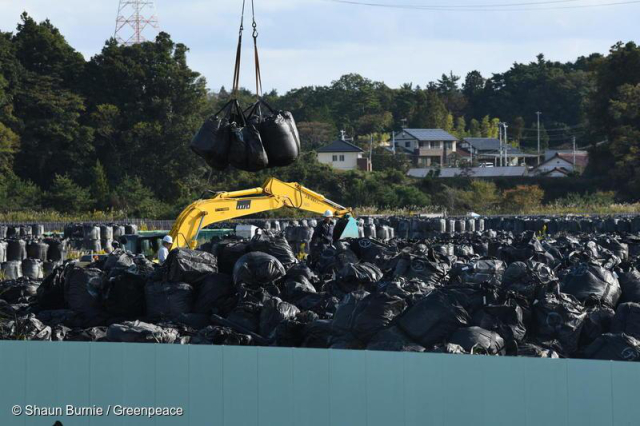
The decontamination program has used over 70,000 workers in Fukushima since 2011. United Nations Special Rapporteurs have expressed their urgent concerns to the Japanese government over radiation risks to workers and their long-term health. 2017/10/01 Shaun Burnie / Greenpeace
Now there are about 1.25 million cubic tons of nuclear wastewater at Fukushima Daiichi Nuclear Power Station. And it is still increasing by an average of about 150 cubic tons per day, aiming to cool the nuclear reactors inside the damaged nuclear power plant. The latest technology named ALPA that Tokyo Electric Power Company applies to treat sewages cannot remove radioactive tritium (extra-heavy water) or carbon 14 (C-14), nor can it remove other radioactive isotopes, such as strontium 90 (Sr-90), iodine 129 (I-129) and cobalt 16 (Co-16).
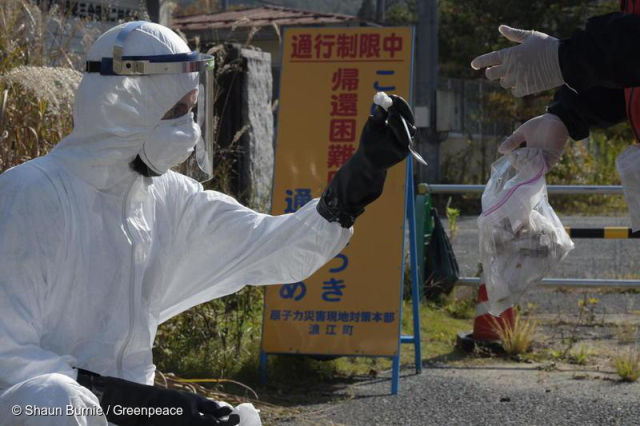
Mathier Soete, radiation protection advisor from Greenpeace Belgium, in Tsushima, Namie exclusion zone, Fukushima Prefecture. 2019/11/02 Shaun Burnie / Greenpeace
The Japanese official insisted the "qualified" wastewater is in line with the "environmental requirements" of nuclear sewage. However, there are no relevant international discharge standards. Because the Fukushima nuclear disaster is the most severe atomic leakage accident since the Chernobyl nuclear accident in the Soviet Union in 1986, and it is also an unprecedented nuclear disaster. Japan has made the so-called "environmental requirements" of nuclear sewage. Therefore, the wastewater is "qualified" to discharge into the sea.
It was in 2018, Tokyo Electric Power Company admitted that the ALPA that it applies to treat sewage could not remove radioactive tritium (extra-heavy water) or carbon 14 (C-14), nor can it remove other radioactive isotopes, such as strontium 90 (Sr-90), iodine 129 (I-129) and cobalt 16 (Co-16). At that time, the world started to realise that 70% of the treated nuclear wastewater in the latest data failed to meet the discharge standards set by the Japanese government itself. Before that, the company had regularly published so-called data on the radioactive elements in the nuclear sewage stored at Fukushima Daiichi Nuclear Power Station.
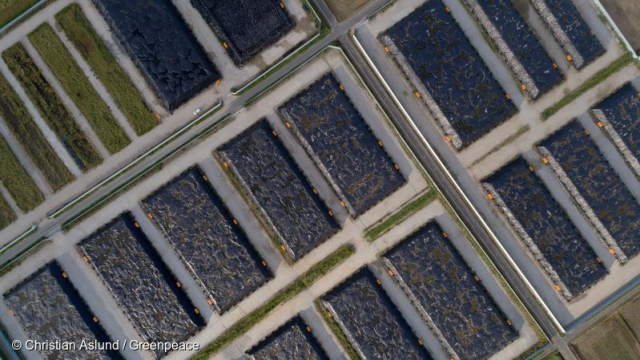
Aerial view of a nuclear waste storage area in Namie, Fukushima prefecture in Japan. 2017/09/19 Christian Åslund / Greenpeace
Q: Will eating marine products containing radioactive substances endanger human health? What effects will it have on human body?
Shaun Burnie: Dependent on factors above - but mainly centered around consumption of contaminated marine food. The modeling of TEPCO to show limited very low exposure has been questioned by scientists in Japan. Underestimating human exposure and effects has been a common theme in Japan over the decades - and the Fukushima water issue is no different. In their 2018 conclusion, Eyrolle, F et al, states, “Our work raises immediate concerns regarding post-accidental management of tritium emissions with direct application to the case of Fukushima (Japan). It also provides additional key knowledge for the future management of tritium releases from nuclear industries.” There can be no justification for the failure of the Japanese government and TEPCO to fully explain the potential impacts of radioactive tritium discharges into the environment.
In terms of the other radionuclides, concentrations in marine life and humans have the potential to increase collective dose rates over time as a result of the discharges, which means increased risk of negative health effects, including cancer and genetic damage – for example from strontium-90 and carbon 14 exposure.

Greenpeace radiation survey team Mai Suzuki, Greenpeace Japan and Mari Chang Greenpeace Korea at Azuma Stadium, Fukushima City. 2019/10/18 Shaun Burnie / Greenpeace
Two examples highlight the potential health issues – the main route of exposure would be ingestion through consumption of contaminated marine food. Because of its long environmental half-life of 5,730 years, carbon-14 is a major contributor to global human collective dose over time, and doses in an exposed population can be converted into the corresponding number of health effects. It is integrated in cellular components, such as proteins and nucleic acids, particularly in cellular DNA. The resulting DNA damage may lead to cell death or potentially inheritable mutations.
In the case of strontium-90, which concentrates in bones, results have shown that exposure can induced double strand breaks in DNA. Due to its high solubility in water and long half-life (29 years), this radionuclide persists in the environment for a long time and progressively enters the food chain.
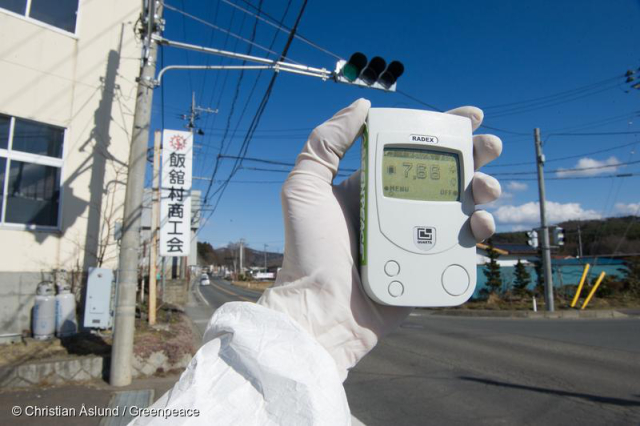
A Greenpeace team member holds a Geiger counter displaying radiation levels of 7.66 micro-Sievert per hour Iitate village, 40km northwest of the crisis-stricken Fukushima Daiichi nuclear plant, and 20km beyond the official evacuation zone. 2011/03/27 Christian Åslund / Greenpeace
Greenpeace's first concern is for the communities in Fukushima prefecture, including their fisheries, who will be most impacted. However, the radioactivity will spread through ocean current. The large releases that occurred from March 2011 show radioactive cesium reaching the East China Sea. See for example this study / modeling from Nanjing University of Information Science and Technology published in 2018. It was previously believed that the East China Sea did not receive any significant cesium contamination, but it was found in this modeling to be contaminated by Fukushima – the cesium discharges from 2011 into the Pacific Ocean spread widely reaching the East China Sea by 2013, reaching their peak in 2019.
Q: Some experts believe that storing sewage in a sturdy storage tank is the most environment-friendly measure. Do you agree with this view? Is it feasible with Japan's existing technical conditions? In addition, are there other scientific methods for storing nuclear waste water?
Shaun Burnie: A decision by the Japanese government to deliberately release the contaminated water violates basic environmental principles. If a decision can be made to avoid contamination of the environment you do so. TEPCO and the Government committee on water have acknowledged that there is sufficient storage space on the Fukushima Daiichi site, as well as on the surrounding area of Fukushima prefecture to build additional storage capacity. There is no 2022 deadline in reality – that is being used in an attempt to justify a decision.
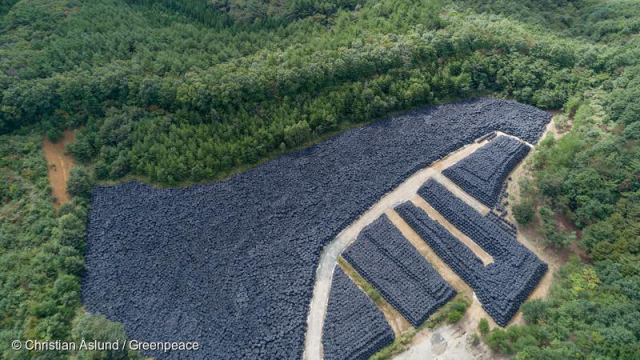
Aerial view of nuclear waste storage area in the mountainous forests of Iitate, Fukushima prefecture in Japan. Adopting a return to normal policy, the Japanese government undertook an unprecedented decontamination program for areas of Fukushima contaminated by the triple reactor meltdown in March 2011. 2017/10/01 Christian Åslund / Greenpeace
The Japanese Government's contaminated water sub-committee (February 2020) identified that storage over the long term was possible, on the site, and in particular off site in the area where enormous interim nuclear waste storage facilities have been built (Okuma and Futaba). The reason they were ruled out is politics – it would take time to negotiate and storage space is running out (it’s not) – to commit to storage would be to directly undermine Japanese government objectives to be able to claim that decommissioning of Fukushima Daiichi is on track – will be completed within 3-4 decades, and all radioactive material will be removed from Fukushima. All of these are delusional – based not on science or engineering realities but dogma.
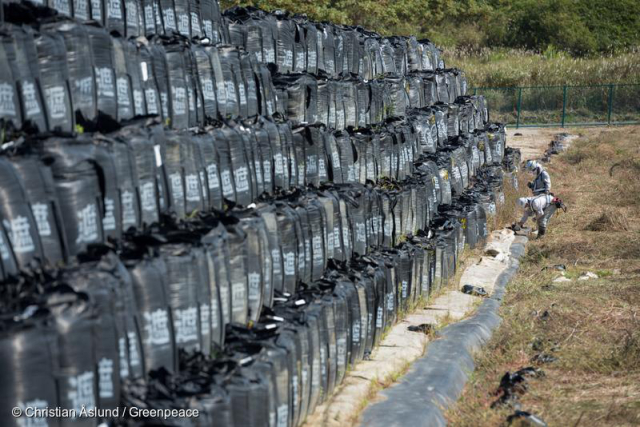
Nuclear waste storage area in Iitate, Fukushima prefecture in Japan. 2017/10/01 Christian Åslund / Greenpeace
Q: The discharge of nuclear waste water into the ocean will affect global fish migration, ocean fisheries, human health, and ecological safety. Therefore, this issue is not just a domestic issue in Japan, but an international issue involving global marine ecology and environmental security. In response to this incident, how do international organizations view it?
Shaun Burnie: Any decision by the Japanese government to discharge ignores the human rights of Japanese citizens to be protected from harmful radiation exposure as well as in neighboring countries – as the UN human rights Special Rapporteurs warned in June 2020;
A decision to discharge also disregards its legal responsibilities (under UNCLOS – UN Convention for the Law of the Sea) whereby Japan is required to inform and consult countries that will be impacted by discharges of radioactivity into the Pacific Ocean.
The only acceptable option for Greenpeace is for the Japanese government to commit to long term storage of the contaminated water, and not to discharge into the Pacific Ocean.
Q: How do local fishermen in Japan view the government's decisions? Are there any objections?
Shaun Burnie: The Federation of Japan Fisheries Cooperatives has continued to express its complete opposition to ocean discharges. Chairman Hiroshi Kishi said “extremely regrettable and totally unacceptable” in response to the government's decision, according to Asahi News.
Q: As an NGO, have you taken any measures to oppose the government's decision?
Shaun Burnie: Since 2012, Greenpeace has proactively campaigned against plans to discharge Fukushima contaminated water - submitting technical analysis to UN agencies, holding seminars with local residents of Fukushima with other NGOs, petitioning against the discharges and submitting to relevant Japanese government bodies. On April 12th, Greenpeace submitted the petitions against the water discharge to the Japanese government.

The cover of Greenpeace's report on Fukushima radioactive water crisis.
Authors: Xu Mian, Ling Xi, Nan, Monica, Hannah
Editor: Jerry




